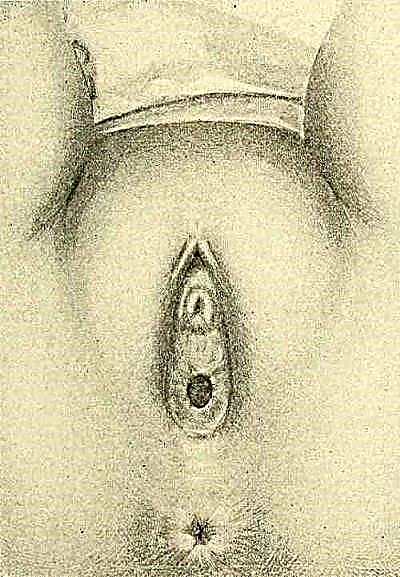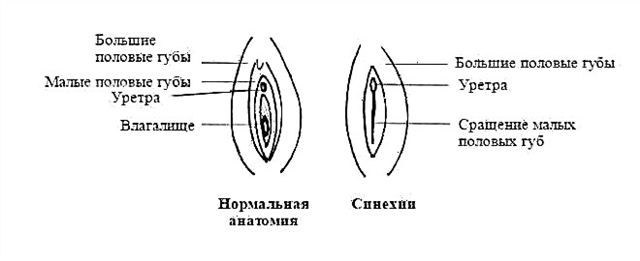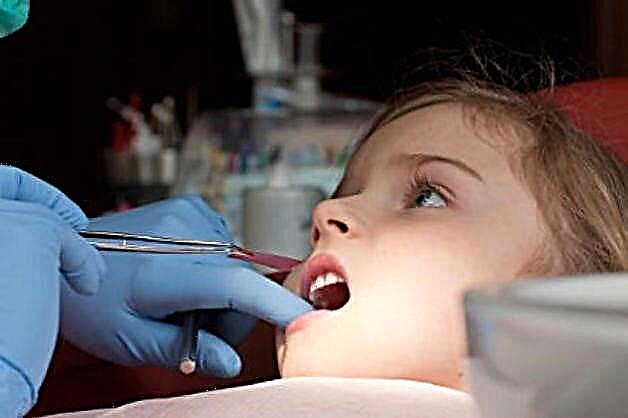
Caring parents, at heart, dream of one day becoming even more caring grandparents. Problems that relate to the genitals and reproductive system of the child are of concern to many. You will learn how synechiae look like in girls, how to recognize them, after reading this article.
What it is?
Synechiae is called adhesion - fusion of the labia with each other. In the vast majority of cases, the labia minora are connected. However, it also happens that large lips grow together symmetrically with small ones.

Doctors believe that this is due to a physiological shortage of female sex hormones at a young age.
It is estrogens that make the labia elastic, dense, tight. After giving birth to a newborn girl, a large amount of estrogen is inherited from her mother. It is protected from adhesion.
However, hormonal stores are consumed and not replenished, and by the age of six months, every girl can experience what synechia is. There are many provoking factors. This is insufficient hygiene, and inflammatory processes that occur in the external genital organs as a result of infection with bacteria, and inflammation, which become a consequence of irritation of the skin and mucous membranes during an allergic reaction, taking medications, contact with allergens, alkalis, aggressive detergents.

Lips can partially grow together, and this will be moderate synechia, or they can merge by a third, half or completely. Such synechia will be called complete.
Sometimes this pathology is complicated by inflammation due to the fact that not only the entrance to the vagina is closed, but also the entrance to the urethra... Vaginal discharge has no outlet and becomes a source of inflammation and a threat to the entire reproductive system of the girl, and urination becomes difficult. This synechia is called complicated.
Light forms of adhesion do not need treatment. Complete synechiae and complicated forms should be treated as soon as possible. That is why it is important for parents to be able to detect pathological adhesions, recognize them and consult a doctor in time.

Symptoms
In the overwhelming majority of cases, synechia (or several synechia) is found on a routine routine examination by a gynecologist. And all because girls rarely make it clear that something bothers them, because the fusion occurs imperceptibly, it is not felt, the child has no pains and complaints. But attentive parents can and should suspect that something is wrong even on the basis of minimal changes in the child's behavior and the appearance of the genitals of a little daughter. Pay attention to the following signs.

Behavior and well-being
With partial (smoothly developing) synechia, the child's behavior does not change. The fusion process can develop for several months, very slowly, or it can happen quite quickly. In order not to overlook the pathology, parents should carefully examine the external reproductive organs of their daughter after an evening bath.
With complete synechiae, when the fused labia minora block the urethra, it will be easier for parents to understand that something is wrong with the child. With each urination, the girl will push, strain, and worry a lot. This form of adhesion does not cause severe pain, but causes a feeling of a mechanical barrier. Therefore, most likely, there will be no screaming, crying and loud "signals" for help.

Capriciousness, crying when urinating, impaired appetite of the baby, restless sleep in infants - such signs can accompany complicated synechiae. In such cases, inflammation develops - vulvitis or vulvovaginitis, in which the child experiences pain during urination, almost constant itching and tingling in the labia and vaginal opening.
An older girl may well complain that it hurts her to write. Such complaints cannot be ignored. You should not immediately start treating a child for cystitis at home. First, you should carefully examine the girl's genitals for possible synechia.

Visual inspection
It is best to examine the girl's genitals in the evening, before going to bed (after an evening swim). This should be done in a well-lit room. If there is not enough light, then you should use a flashlight. The girl needs to be put on her back and carefully inspect the genital slit.

Synechiae look like membranous membranes connecting the labia. The film has a fairly dense texture, it can look stretched - both horizontally and diagonally. In the center of the film you can see a small “seam” - the line along which the fusion developed.
With partial synechiae, fusion of the lower third of the labia minora usually occurs. However, it so happens that the upper parts grow together. Moderate synechiae is not accompanied by any other visual signs.
When the genital gap is overgrown, the film will be completely distinguishable, it will not be difficult to see it. But to see the entrance to the vagina, if it is closed, or the urethra, if it is also under the film, will be very difficult.

With a complicated form of this pathology, the picture will be much more picturesque. The external genitals will appear somewhat swollen and reddened. Perhaps there will be scratches and small wounds - if the girl itched due to itching. Vaginal discharge from vaginitis or vulvovaginitis will be yellowish, white-yellow or purulent, with a rather pungent and unpleasant odor.
If there are problems with urination, then the upper third of the labia will look inflamed. Redness will be well localized around the urine outlet area.
Signs of the initial stage
It is rather difficult to consider synechiae at the initial stage. Before full fusion has begun, the adhesive film usually looks like separate strands stretched between the labia.
Parents should be aware that do not try to tear the film or individual threads with your hands. This will cause severe pain to the child and pose a threat of genital infection. The division of synechiae should be dealt with by specialists - with the help of instruments and not without local anesthesia.

Signs of an "advanced" stage
A dense opaque film of a bluish or grayish hue, behind which practically nothing can be seen, is a symptom of a "neglected" long-standing problem. The presence of inflammation, redness, rash and discharge depends on whether the fusion is complicated or not, whether it is complete.
Changes in the behavior of the child with long-standing synechiae will be insignificant. If something bothered the girl at first, then, most likely, the body has already learned to compensate for the inconvenience, and the baby is vigorous and active - if there is no inflammation in the acute stage.

Where to contact?
A pediatric gynecologist can assess the situation, who will examine the synechiae with a professional look and tell you what and how to do. You should not be afraid to go to an appointment, because in almost 90% of cases, treatment is not needed. The synechiae will go away on their own when puberty begins.

Just in case, the doctor will definitely take samples of smears to determine the pathological microflora, and also prescribe general blood and urine tests. With severe inflammation, an ultrasound examination of the pelvic organs may be required.
The diagnosis, in which the concepts of "complete" and "complicated", unabsorbed synechia in adolescent girls are sounded, may be grounds for surgical treatment. However, more often it is possible to solve the problem conservatively, using ointments and creams - even before the girl turns 9-10 years old.




